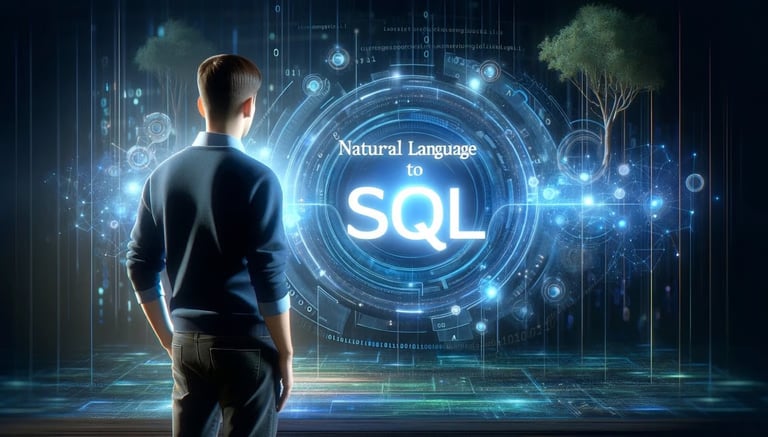QueryGPT – Natural Language to SQL Using Generative AI
GENERATIVE AI
8/5/20253 min read


QueryGPT – Natural Language to SQL Using Generative AI
Introduction
In today’s data-driven world, accessing and analyzing information quickly is critical for decision-making. However, not everyone is fluent in SQL—the language of databases. Enter QueryGPT, a generative AI-powered solution that translates natural language queries into SQL statements, making data access more intuitive and inclusive.
This blog explores how QueryGPT works, its architecture, use cases, and how it’s transforming the way businesses interact with data.
The Problem: Bridging the Gap Between Humans and Databases
SQL (Structured Query Language) is the standard for querying relational databases. While powerful, it requires technical expertise. Business analysts, product managers, and other non-technical stakeholders often rely on data teams to fetch insights, creating bottlenecks and delays.
Imagine asking, “Show me the top 10 products by revenue last quarter,” and instantly receiving the correct SQL query. That’s the promise of QueryGPT.
What is QueryGPT?
QueryGPT is a natural language interface to databases powered by generative AI. It uses large language models (LLMs) to understand user intent and generate syntactically correct and semantically meaningful SQL queries.
At its core, QueryGPT combines:
Natural Language Understanding (NLU): Interprets user queries.
Schema Awareness: Understands the structure of the target database.
SQL Generation: Produces executable SQL statements.
Validation & Execution: Ensures queries are safe and accurate before running them.
How QueryGPT Works: Step-by-Step
1. Input Parsing
The user inputs a query in plain English, such as:
“List all customers from New York who made purchases over $500 in the last 6 months.”
The system parses this input to identify entities (customers, purchases), filters (New York, > $500), and time constraints.
2. Schema Mapping
QueryGPT accesses metadata about the database schema—tables, columns, relationships, and data types. This context is crucial for generating accurate queries.
For example, it might map:
“customers” → customers table
“purchases” → orders or transactions table
“New York” → city column in customers
3. SQL Generation
Using a fine-tuned LLM (e.g., GPT-4 or open-source alternatives), QueryGPT generates the SQL query:
FROM customers c
JOIN orders o ON c.customer_id = o.customer_id
WHERE c.city = 'New York'
AND o.amount > 500
AND o.order_date >= CURRENT_DATE - INTERVAL '6 months';
4. Validation and Execution
Before execution, the query is validated for:
Syntax correctness
SQL injection risks
Performance (e.g., avoiding full table scans)
Once validated, the query is executed, and results are returned to the user.
Key Features of QueryGPT
🔍 Schema-Aware Intelligence
QueryGPT doesn’t just guess—it understands your database schema. This ensures queries are accurate and relevant.
🛡️ Secure Query Generation
Built-in safeguards prevent malicious or inefficient queries, protecting your data and infrastructure.
📊 Multi-Database Support
QueryGPT can be adapted to work with PostgreSQL, MySQL, SQL Server, Snowflake, BigQuery, and more.
🧠 Contextual Memory
It can remember previous queries and refine them, enabling conversational data exploration.
Use Cases
1. Business Intelligence
Empower non-technical users to explore data independently. For example:
“What was the average order value in Q2 across all regions?”
2. Customer Support
Support agents can query customer histories without writing SQL:
“Show me all interactions with customer ID 12345 in the last year.”
3. Product Analytics
Product managers can ask:
“Which features are most used by premium users?”
4. Finance and Operations
Finance teams can query:
“Total expenses by department for the last fiscal year.”
Implementation: Building Your Own QueryGPT
🔧 Tech Stack
Frontend: React or Streamlit for UI
Backend: FastAPI or Flask
LLM: OpenAI GPT-4, Mistral, or LLaMA
Database: PostgreSQL, MySQL, etc.
Vector Store (optional): For schema embeddings (e.g., FAISS, Pinecone)
🧱 Architecture Overview
User Interface: Accepts natural language input.
LLM Engine: Processes input and generates SQL.
Schema Retriever: Supplies database metadata.
Query Validator: Checks for safety and correctness.
Executor: Runs the query and returns results.
🧪 Sample Code Snippet
from fastapi import FastAPI, Request from openai import OpenAI import psycopg2 app = FastAPI() @app.post("/query") async def generate_sql(request: Request): data = await request.json() user_query = data["query"] prompt = f""" Convert the following natural language query to SQL: Query: "{user_query}" Schema: customers(id, name, city), orders(id, customer_id, amount, order_date) """ response = OpenAI().chat_completion(prompt) sql_query = response["choices"][0]["text"] # Execute SQL safely... return {"sql": sql_query}
Challenges and Considerations
⚠️ Ambiguity in Language
Natural language is inherently ambiguous. QueryGPT must handle vague queries gracefully, often by asking clarifying questions.
🔐 Data Privacy
Ensure that sensitive data is protected. Role-based access control and query auditing are essential.
🧠 Model Fine-Tuning
Generic LLMs may not perform well out-of-the-box. Fine-tuning on domain-specific queries and schemas improves accuracy.
🧪 Testing and Evaluation
Use benchmarks to evaluate:
Query accuracy
Execution success rate
User satisfaction
Future of QueryGPT
The future is bright for natural language interfaces to data. Advancements in multimodal models, retrieval-augmented generation (RAG), and schema embeddings will make QueryGPT even more powerful.
Imagine voice-based querying, real-time dashboards, and proactive insights—all powered by conversational AI.
Conclusion
QueryGPT is revolutionizing how we interact with data. By translating natural language into SQL, it democratizes access to information, boosts productivity, and reduces dependency on technical teams.
Whether you're a startup or an enterprise, integrating QueryGPT into your data stack can unlock new levels of agility and insight.
Ready to build your own QueryGPT? Let’s talk about how you can integrate it into your workflow or product. I can also help you design the architecture, write the backend, or fine-tune your model.
Location
Address: Workshaala Vista, N R Tower, 2nd Floor, 17th Cross Road, 19th Main Rd, Sector 4, HSR Layout, Bengaluru, Karnataka 560102
Contacts

Copyright © 2025 by Oliware Technologies Pvt Ltd.
